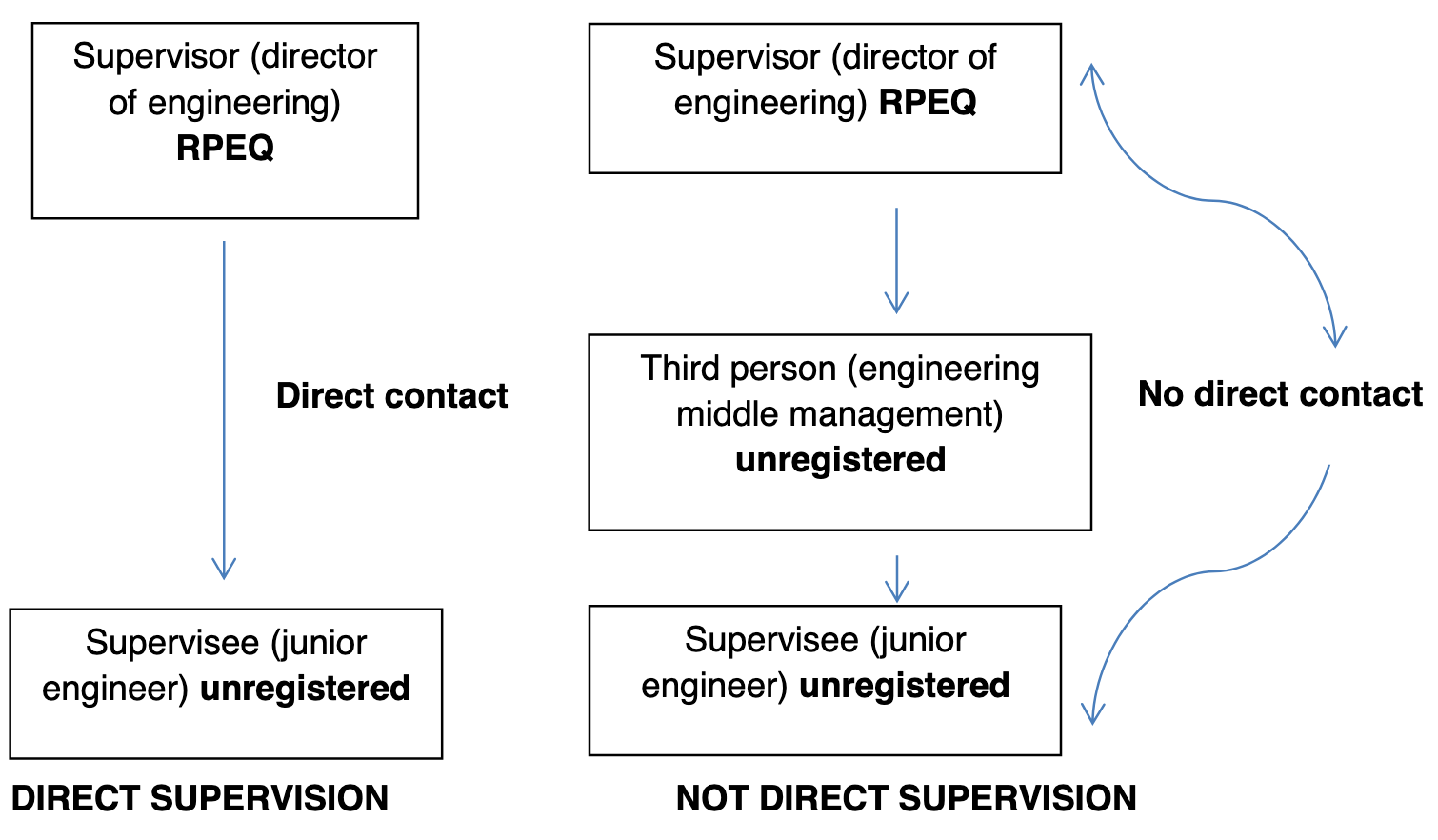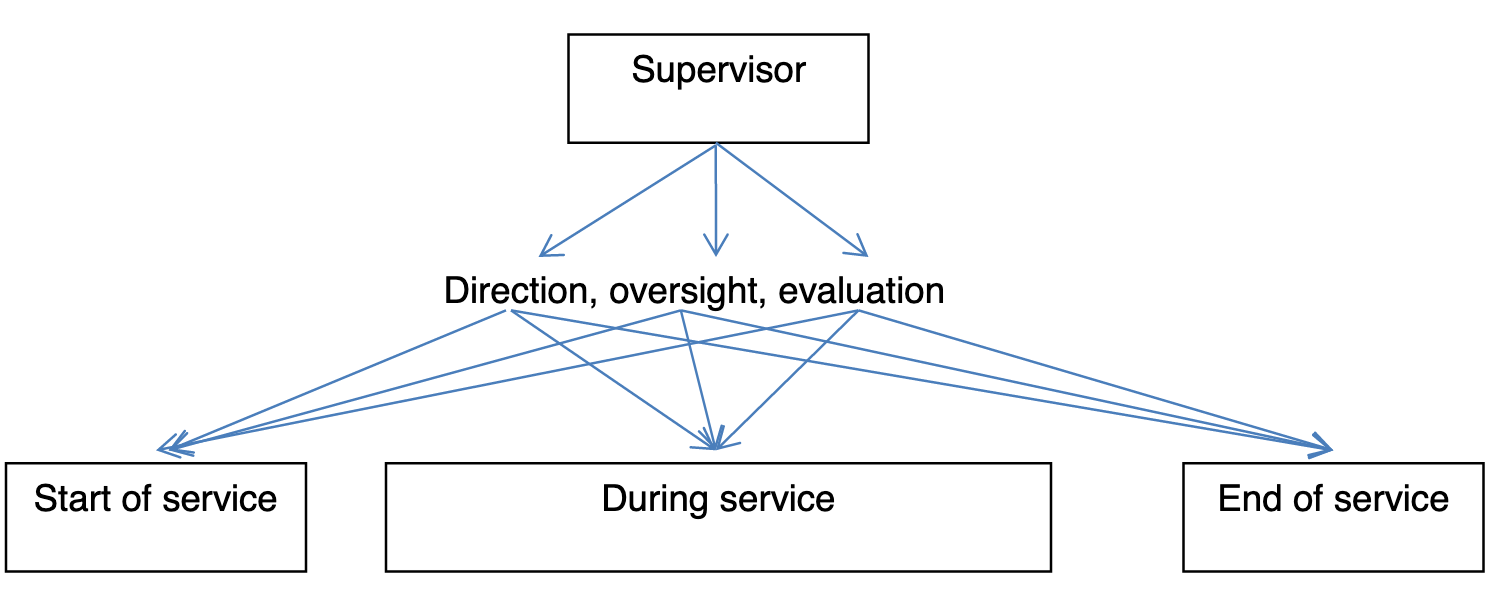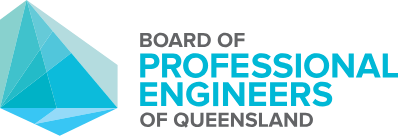18 Jun Direct Supervision
Practice Note ID: 4.5 (1A)
Status: Approved
Issued: 5 February 2014
Rationale
A number of Registered Professional Engineers of Queensland (RPEQ) have made enquiries to the Board of Professional Engineers of Queensland (Board) about the concept of ‘direct supervision’ of a person carrying out a professional engineering service,1 as contemplated by the Professional Engineers Act 2002 (Act). The purpose of this practice note is to provide an explanation of the concept of direct supervision.
1 Please see the Board’s Practice Notes 4.3(1A) Professional engineering services and prescriptive standards, and 4.4 Elements of a professional engineering service, for a more detailed explanation of professional engineering services.
Introduction
The Act provides that a person who is not a RPEQ must not carry out professional engineering services.2 A person who does so commits an offence, and is liable to a maximum penalty.3 However, this is not the case if the unregistered person carries out the professional engineering services under the direct supervision of a RPEQ who is responsible for the services.4
The Act provides that a RPEQ must not carry out professional engineering services in an area of engineering other than an area of engineering for which the RPEQ is registered.5 For example, a RPEQ Electrical must not carry out professional engineering services in the Civil area of engineering. A RPEQ who does so commits an offence, and is liable for a maximum penalty.6 However, again, this is not the case if the RPEQ carries out the professional engineering services under the direct supervision of another RPEQ who is registered in the area of engineering and responsible for the services.7
If a person who would not otherwise be allowed to carry out particular professional engineering services carries out the services under the direct supervision of an appropriately qualified RPEQ who is responsible for the services, that person will not contravene the Act.
2 Professional Engineers Act 2002(Qld) s 115(1).
3 Professional Engineers Act 2002(Qld) s 115(1). A penalty unit is currently $110.00: Penalties and Sentences Act 1992(Qld) s 5(1)(d).
4 Professional Engineers Act 2002(Qld) s 115(2).
5 Professional Engineers Act 2002(Qld) s 115(3).
6 Professional Engineers Act 2002(Qld) s 115(3). A penalty unit is currently $110.00: Penalties and Sentences Act 1992(Qld) s 5(1)(d).
7 Professional Engineers Act 2002(Qld) s 115(4).
Requirements of the Act
The Act provides that a person carries out professional engineering services under the direct supervision of a RPEQ only if the RPEQ directs the person in the carrying out of the services and oversees and evaluates the carrying out of the services by the person.8
The Code of Practice for Registered Professional Engineers (Code) states that if a RPEQ supervises a person in carrying out professional engineering services within the meaning of section 115 of the Act, the RPEQ must, in the role of the supervisor: have sufficient knowledge of the professional engineering services carried out; (b) sufficient control over any outputs of the professional engineering services to reasonably form the view that the standard of the professional engineering services is that to be expected of a RPEQ; and take full professional responsibility for the professional engineering services provided by that person.9
8 Professional Engineers Act 2002(Qld) s 115(5).
9 Code of Practice for Registered Professional Engineers, paragraph 3.6.
Practice
Based on the provisions of the Act and the Code, the objects of the Act, and the history of the amendments to the Act, the Board considers that for supervision to be ‘direct supervision’ as required by the Act, each of the following five elements must be satisfied:
(a) the supervision must be direct;and
(b) the supervising RPEQ must direct the person in the carrying out of the service;and
(c) the supervising RPEQ must oversee the carrying out of the service by the person;and
(d) the supervising RPEQ must evaluate the carrying out of the service by the person;and
(e) the supervising RPEQ must take full professional responsibility for the service.
The supervision must be direct. The supervisor must have direct contact with the supervisee and actual knowledge of the professional engineering service being provided. Depending on the nature of the service being supervised, direct contact need not be in person, but may be through written correspondence (letters, drawings, or emails), telephone, or voice or video chat. However, the contact must be directly between supervisor and supervisee, and not through a third person.
Diagram 1: Examples of appropriate and inappropriate supervision

Also, again depending on the nature of the service being supervised, the supervisor may not need to be physically present at the site where the service is being carried out. However, the supervisor must still have sufficient knowledge of every significant element of the service being undertaken. Such knowledge might only be attainable by the supervisor being physically present at the site, but in some cases could be gained through photographs or video footage, or review of site investigation notes prepared by the supervisee. The type of direct contact and actual knowledge required will depend on the actual circumstances of each situation.
The supervising RPEQ must direct the person in the carrying out of the service. The supervisor must not merely observe the carrying out of the service by the supervisee, but must be in control of the carrying out of the service, in the sense of directing the supervisee in the carrying out of the service. Supervision will not be direct supervision if the supervisor allows the supervisee to have free reign in how the service is carried out.
The supervising RPEQ must oversee the carrying out of the service by the person. The supervisor must be involved at all stages of the carrying out of the service by the supervisee. Supervision will not be direct supervision if a supervisor merely checks the completed service and approves or ‘signs off’ on it. Certification or approval at the conclusion of a service is not sufficient to constitute direct supervision without all other elements of direct supervision also being present.
The supervising RPEQ must evaluate the carrying out of the service by the person. The supervisor must be satisfied that, at all times, the service is being carried out by the supervisee to a standard which might reasonably be expected of an RPEQ, in a professional and competent way, exercising adequate knowledge, skill, judgement, and care. This will require the supervisor to be satisfied about the information the supervisee has gathered, the calculations the supervisee has made, and the judgements the supervisee has made in the application of engineering principles and data to the carrying out of the service.
Diagram2: A diagram of appropriate direction, oversight, and evaluation

Finally, the supervising RPEQ must take full professional responsibility for the service. This means that if a complaint is made about the standard of the service supervised, the supervisor must accept that the complaint will attach to them as the person who provided direct supervision of the carrying out of the service, and not the supervisee, and that they may be subjected to investigation and subsequent disciplinary action by the Board.
The exact requirements for direct supervision will vary depending on the nature and circumstances of the service being supervised.
Finally, the Board considers that both the supervisor and supervisee should document, and retain documentation of, the supervision provided by the supervisor, to be produced if verification of the existence and nature of the supervision is ever required.
References
Acts Interpretation Act 2002(Qld).
Professional Engineers Act 2002(Qld).
Code of Practice for Registered Professional Engineers.
Australian Concise Oxford Dictionary.
Version 1.2 –5 February 2014

 MY ACCOUNT
MY ACCOUNT
